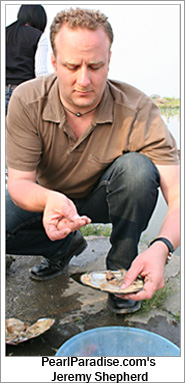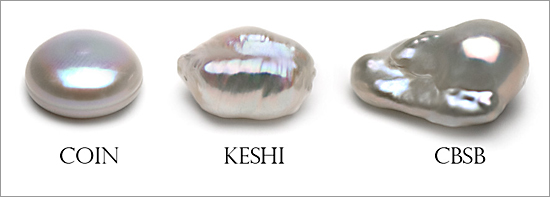In April of this year, PearlParadise.com CEO Jeremy Shepherd and GIA writer Doug Fiske traveled with GIA photographer Valerie Power to the Weitang and Zhuji regions, centers of the Chinese freshwater pearl industry. For nearly a week, we interviewed farmers, traders, and even the chairman of one of the largest freshwater pearl production companies. The information we gathered gives a clear picture of where the industry is today and a detailed explanation of coin-bead/spherical bead (CBSB) freshwater pearls, some of which are called "fireballs."
Current Production
Several sources reported a 2006 total Chinese freshwater output of 1,500 metric tons, of which 800 metric tons are suitable for jewelry. Of the 1,500 metric tons, the vast majority are tissue-nucleated pearls. Although spherical bead nucleation is a reality in China, bead-nucleated pearl volume is relatively small.
Over the last few years, people in the industry have noticed a clear increase in the quality of Chinese freshwater output. Size, shape, and even color have improved remarkably. This is due in part to the fairly new practice of fewer nucleations in each valve of the mussel. In the past, up to 25 tissue pieces were inserted in the mantle of each valve. Today, only 12 to 16 pieces of tissue are implanted, producing a total of 24 to 32 pearls per mussel. The fewer-grafts method has had a direct effect on the quality and size of the pearls.
 The Triangle Mussel
The Triangle Mussel
It is widely known that Chinese pearl farmers use the triangle mussel (Hyriopsis cumingi) to culture freshwater pearls. This mussel replaced the cockscomb mussel (Cristaria plicata) nearly a decade ago.The cockscomb mussel was responsible for the Rice Krispie freshwater pearls that China first became known for. The switch to the triangle mussel is significant in that it led to the higher-quality production seen today.
Introduction of the Biwa Pearly Mussel
Today, there's another new mussel in Chinese freshwater pearl culture. The transformation is leading to even higher quality freshwater cultured pearls in more saturated colors and larger sizes.
During an interview in Zhuji, the chairman of Grace Pearl mentioned a mussel that we did not know as native to China. The literal translation was “pond butterfly mussel.” Although culturing Chinese freshwater pearls in the mussel began within only the last few years, it is already responsible for about 30 percent of China’s production. We were unable to determine the scientific name of the mussel, so we turned to Chinese news articles and scientific journals. What we found was startling: The scientific name for “pond butterfly mussel” is Hyriopsis schlegeli. In Japanese, it’s ikecho. Its common name is Biwa pearly mussel. In effect, the Chinese have been producing Biwa pearls for several years.
The first report of the Biwa pearly mussel having been imported to China from Japan appeared in a scientific journal in 1997. The Hongmen City Reservoir Development Company began raising Biwa pearly mussels in hatcheries and experimenting with their pearling potential in China. They found that the mussel had greater vitality and produced better pearls overall. The advantages for the Chinese pearl industry were obvious. But researchers did not stop with the simple use of the Biwa mussel. They cross-bred it with the triangle mussel, thereby creating a hybrid that is better than either pure species with respect to pearl culture. There is no scientific or common name for the hybrid. Loosely translated, the Chinese call it the "leisure mussel."
Introduction of “Fireball” Cultured Pearls
The Biwa pearly mussel and its triangle-mussel hybrid have undoubtedly changed the course of Chinese freshwater pearl culture. At about the same time, a new pearl entered the scene and gained popularity. It’s a bead-nucleated freshwater pearl that the trade dubbed “fireball.” It’s called that because the pearl often has a tail that makes it look like a comet. An alternative term is CBSB, which is short for coin-bead/spherical bead. The term accurately describes the process that sometimes produces fireballs.
CBSB production has prompted great interest, particularly regarding the genesis of the tail. Stories abound of mythical “pearl nucleation” and organ implantation. But what is the real story?
CBSB production involves a number of steps, each equally important. Spherical bead-nucleated freshwater pearls are not, as many assume, created by the insertion of a piece of mantle tissue and a spherical bead nucleus. That is the common method of culturing bead-nucleated pearls in the gonad of saltwater mollusks. Freshwater mussels do not have the gonad anatomy nor the necessary space between the valves to bead nucleate in the mantle with a spherical bead when the mussel is young.
The Three-Step CBSB Process
Traditional tissue nucleation is done with mussels that are six months to one year old. For the first CBSB step, Mr. He Jainhua, a pearl farmer who specializes in bead-nucleated freshwater pearls, uses three-year-old triangle mussels. He begins with an incision, a coin bead, and 1-mm-square piece of mantle tissue. The host mussel’s mantle completely encloses the flat coin bead. The first step in bead-nucleated pearl production is the creation of a one-year coin pearl.
After that first year, there are two routes the farmer can take. He can remove the coin pearl and return the mussel to the water to create a keshi pearl in the existing pearl sac, or he can leave the mussel in the water to add nacre to the coin pearl. Either way, this second step takes an additional year.
The third step is the production of freshwater pearls that have a spherical bead nucleus. When the mussel is five years old, the farmer removes either the keshi pearl or the coin pearl. He then inserts a spherical bead nucleus in the existing pearl sac. Except that it’s in the mantle rather than the gonad, the technique is similar to growing second-graft Tahitian or South Sea cultured pearls. Both techniques use the existing pearl sac.
The pearl sac, which forms a bulge in the mantle, is a perfect nacre-producing pocket. The pearl growth period at this point can be one or two years. Because beads as large as 12.5 mm are implanted, the resulting bead-nucleated pearls can be of substantial size.

The Reason for the Tail
Why do the CBSB pearls often have tails? Although the reasons are not completely clear—even to the farmers in China—we observed two strong factors. The first factor is the insertion of a spherical bead into an existing pearl sac through an incision made to harvest the coin or keshi. The sac accepts the bead but can leave a void adjacent to the incision. If the sac envelops the bead and the incision heals, there will be no tail.
The second factor involves the elasticity of the pearl sac. An analogy is the pearl sac as a plastic bag and the spherical bead as a ball. If you press the ball into the bag, at least one section of the bag will be flush against the ball. If the capacity of the bag is greater than the size of the ball, the area of the bag that does not envelop the ball remains flaccid. The bag—the pearl sac—will produce nacre to cover the spherical nucleus and fill the void. The result is a spherical-bead-nucleated cultured pearl with a tail of some shape. Some CBSBs have the long, spiked tails that characterize fireballs.
Giant Clam Beads Likely
CBSB farmers use spherical nuclei that range from 9 to 12.5 mm in diameter. We asked about the origin of the beads. The answer was that the beads come from freshwater mussel shells. It was clear that the beads were not old freshwater pearls. That method had been tried, but it proved not economically or physically feasible.
Still, it remained hard to believe that the beads came from freshwater shells. Seven millimeters is the maximum for spherical beads from Chinese mussel shells. The only freshwater mussels that can produce nuclei between 9 and 12.5 mm in diameter are the mapleleaf (Quadrula quadrula) and the washboard (Megalonaias nervosa), which are both found only in the US rivers and lakes. American mussel shell beads are too expensive for Chinese freshwater pearl farmers. Even highly striated beads like those used in Tahitian and South Sea pearl production would be cost prohibitive in freshwater pearl production. The beads we saw were very large and very white.
Two nuclei were tested at GIA’s Carlsbad laboratory. They proved to be of saltwater origin. The only saltwater shell capable of yielding nuclei that size is Tridacna gigas—the giant clam.
The giant clam is the world’s largest bivalve mollusk. It can weigh as much as 500 pounds, and has a porcelaneous interior. While its size and shell color are ideal for nucleus production, the giant clam is a threatened species. Importing the giant clam or its derivatives is illegal in the US and other countries that are signatories to CITES, an international treaty intended to protect endangered and threatened species. China is not a signatory.
Conclusion
As they did by inventing blister pearl culture about 700 years ago, Chinese pearl farmers are again proving they are and will continue to be a force in the pearl industry. CBSB pearl production and the importation and hybridization of the Biwa pearly mussel are but two examples of continuing innovation in China’s pearl industry. Let’s wait to see what the future holds.


